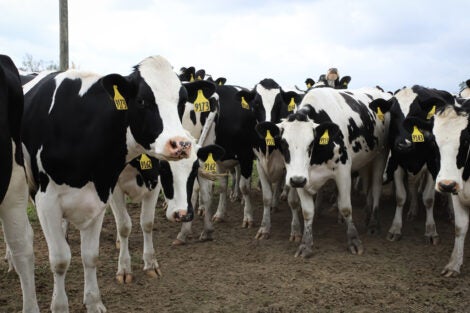May 9, 2024 – Bird flu—H5N1 avian flu virus—has been spreading among dairy cows across the U.S. So far, there’s only one known case of the virus possibly passing from a cow to a human, but experts are concerned there may be more cases we don’t know about, and about the potential for further spread. Bill Hanage, associate professor of epidemiology at Harvard T.H. Chan School of Public Health, doesn’t think that a bird flu pandemic is imminent —at least not yet.
Q: Some experts are saying that the spread of bird flu in cows may be much broader than it appears. Why would that be? Why wouldn’t we have a handle on the spread?

A: Outbreaks at the interface of animal and human health are hard to study in the U.S. because they’re covered by different jurisdictions. The USDA [U.S. Department of Agriculture] oversees farm issues and its focus is on agriculture. While the USDA does have an emergency response team dedicated to influenza, farmers may have concerns about people coming onto their property to collect samples from livestock or workers, and some of those workers may not have documented immigration status. But those workers are at risk of infection, as shown by a case of human infection that occurred in early April. Samples from animals at the relevant farm were reportedly ‘not available’ for testing.
If we can’t collect samples directly from cattle, we have to look at something like milk, and we have indeed found that a lot of tested milk samples contain genetic traces of the bird flu. But that does not tell us how many cows might be infected. It’s not at all clear because the milk we are testing is not from just one cow but many, and so we have no idea how many of them were contributing to the signal. All we can say is that it is certainly not a small number given how many samples are coming back positive, but beyond that we just don’t know exactly how many infected cows there are, where they are, or how many may have been very mildly infected and not detected.
One of the problems is the way public health has been politicized following the COVID pandemic. But the virus doesn’t care what side you’re on—it only cares if you have the appropriate receptors so that it can get into your cells, and from there into somebody else.
Q: What sort of information would help scientists figure out the extent of bird flu spread among cows?
A: Much more sampling, from cattle with and without symptoms, as well as from workers who have contact with them. Ideally this would include antibody tests to determine whether they have been infected and recovered in the past. Transparency is really important when it comes to public health.
While genomes from the outbreak have been made available by the USDA—although they did not do so with alacrity—they were initially criticized for lacking essential content such as when and where the samples were collected, which is really important to start making sense of the spread. It now looks like there was a single introduction from birds into dairy cattle in Texas, which was then disseminated to other states via movement of asymptomatic cattle. We can also see that the genetic variation is consistent with rapid exponential growth. The USDA has recently required dairy cattle to test negative for the virus before being transported across state lines, which is a welcome step. Although at present testing is only required for dairy cows that are lactating, so it is easy to see how the virus could slip through the net. In any case, this may be a case of shutting the barn door after the cow has bolted.
Q: As of now, there’s just one known instance in which a cow appears to have infected a human with bird flu—a case of conjunctivitis in a dairy farm worker from Texas. How could the virus start spreading more in humans?
A: It could adapt to bind to the receptors that are found in our upper airways, which would help respiratory spread. Right now it sticks to receptors deeper in the lung, which is one reason why infections there, when they occur, are so nasty. Cows don’t typically get respiratory infections with the sort of flu viruses that transmit among humans because they don’t have the right receptors in the right place. Instead, milk production seems to be key for transmission in the current outbreak. But pigs can be infected by all sorts of different flu viruses that are also capable of respiratory spread among humans. Previously we’ve seen pandemics arise from what’s called reassortment, in which a pig gets infected with two different viruses, and the genetic material gets mixed up in the pig, and what comes out is a new virus with new properties. That’s one way that the virus might make an evolutionary leap and start to transmit among humans, so we should keep a close eye on pigs to see whether the cattle outbreak is seeding infections into them.
Q: If the virus does start spreading in humans, could that cause another pandemic?
A: It certainly could but it would depend on the state of our immunity to whichever virus gets lucky and exactly how transmissible it is. As it happens, the infections that have been occurring in Texas seem to be a type that is a good match for some existing components of a vaccine that we would be able to start making.
On the other hand, vaccines don’t appear from thin air; they take time to produce. One of the major ways that we make them involves hen’s eggs. Don’t forget, we’re dealing with an avian flu that has affected chickens—outbreaks in poultry farms in two states have recently been detected. As a result of bird flu outbreaks, eggs have been in short supply at some points in the last few years, and that could make ramping up production of a vaccine a more difficult task. We won’t be able to do it overnight. It would take months at the very least.
Another tool we have is the antiviral drug Tamiflu. But to be effective, it needs to be given quite early on in the infection. So we also need to have tests ready.
Q: So if the virus did start to spread quickly, how prepared are we?
A: What disturbs me most about this is that there’s no serious discussion about what we would do if the you-know-what hits the fan. If we were to see any evidence of human-to-human transmission without links to livestock, that would be immensely concerning. If we see larger numbers of such infections in clusters, or even more than one cluster, it would be time to start making vaccine—time to pull out all the stops. The reason is that, in the early stages of infectious disease outbreaks, you’re always playing catchup. You’re racing behind the virus, seeing where it has been, not where it is. You can bet that if we are seeing cases, there are others that we’re not seeing.
Q: Genetic material from H5N1 has been found in pasteurized milk, and the FDA has been testing ground beef. Should we be concerned about risk to humans?
A: Pasteurization inactivates the virus, so pasteurized milk is safe. And right now tests on ground beef have come back negative. We should remember that these tests are exquisitely sensitive, and do not reflect live virus. However, I would avoid unpasteurized or ‘raw’ milk products. There have been several infections in cats that almost certainly were exposed by drinking milk on the farms in question.
Q: What’s the bottom line? How worried should we be about an outbreak?
A: If it was easy for this virus to spread among humans, it would have likely done it already. Having said that, this strain is far better than most bird flu at infecting all sorts of different mammals—there have been outbreaks in seals, farmed mink, and now cattle. We have seen sporadic spillover infections in skunk and racoons among others, as well as the single human case identified so far. All of that indicates that this is a generalist virus [one that can infect and evolve in multiple species]—and those are the ones you want to keep an eye on.
Even though I don’t think there’s reason to believe a pandemic is imminent right now, we will have another flu pandemic at some point, and we should be ready for it. Not having a plan is just beyond stupid. Don’t panic, do prepare.
Photo: iStock/Sabrina Gordon
